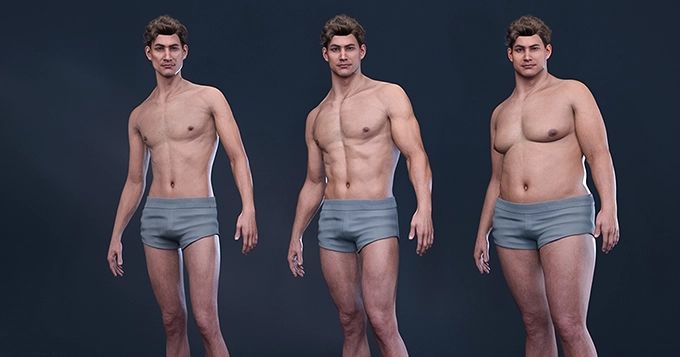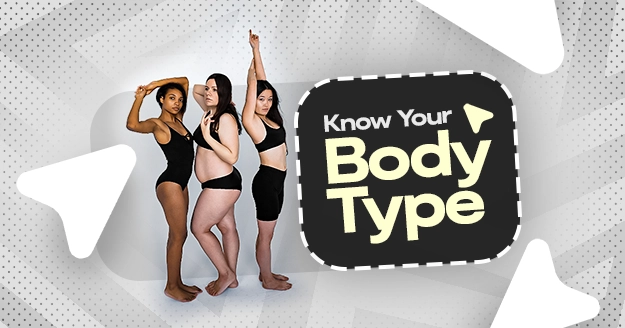
Key Takeaways
- Identify your body type—ectomorph, mesomorph, or endomorph—for a tailored fitness plan.
- Ectomorphs should focus on heavy lifting, minimal cardio, and a calorie-dense diet.
- Mesomorphs benefit from balanced workouts, progressive overload, and a nutrient-rich diet.
- Endomorphs should prioritize HIIT, full-body training, and portion-controlled meals.
- Consistent effort and a personalized approach are essential for achieving fitness goals.
If you’re a gym regular but not achieving your desired results, it might be because your fitness routine isn’t customized for your body type for working out. Just like one-size-fits-all doesn’t work for clothing, it doesn’t work for fitness. Understanding your body type can be the key to unlocking your fitness potential. Let’s delve into how to customize your workout for your athletic body type.
Know Workout Body Types
What is an athletic body type?
Body type, often referred to as somatotype, encompasses an individual’s inherent physique characteristics, including body structure and the ratio of muscle to fat.
Most people misclassify their body type. Primary causes of this include general body insecurities, physical deconditioning, and overly critical self-assessment of their bodies.
Before customizing your workout, it’s essential to identify your body type. The three primary body types are ectomorph, mesomorph, and endomorph.
Ectomorph
Ectomorphs typically have a lean build and struggle to put on muscle. They have a fast metabolism and often struggle to put on weight.
Mesomorph
Mesomorphs have a naturally athletic build with well-defined muscles. They gain muscle mass relatively easily and can also shed fat effectively.
Endomorph
Endomorphs may find it difficult to reduce weight because they often have a higher percentage of body fat. They have a slower metabolism and often have a rounder physique.
Tailoring exercise for different body types is essential for optimizing fitness outcomes and ensuring individuals reach their specific health and wellness goals.
Ectomorph Workout and Diet Guide

If you’re long, lean, and struggle to gain weight, you likely have an ectomorph body type, characterized by a fast metabolism. Adapting your diet and exercise routine to suit this body type can help you change your body composition.
While there’s no one-size-fits-all workout plan for ectomorphs, understanding their common traits can help you create tailored programs. Ectomorphs efficiently burn calories without needing excessive cardio but struggle to gain weight or muscle mass.
Think about basketball players—they often have ectomorph traits because of their high activity levels, which makes gaining weight tough. As ectomorphs age, their metabolism slows down, leading to more body fat and difficulty maintaining muscle mass. Their lean physique and long limbs make losing weight easy but gaining weight a challenge. Adjusting your diet and training methods accordingly is crucial for managing the ectomorph body type.
Tips for Ectomorphs Training and Workout Programming
- Focus on compound exercises such as deadlifts, bench presses, squats, and rows to efficiently stimulate muscle growth.
- Lift heavier weights with lower repetitions to challenge your muscles and promote hypertrophy.
- Incorporate progressive overload to stimulate muscle growth.
- Limit cardio sessions to avoid excessive calorie burning and prioritize strength training.
- Focus on shorter rest periods between sets to maintain intensity and engage muscles.
- Aim for a workout frequency of 3-4 times per week, allowing for adequate recovery between sessions.
- Consider incorporating split training routines to target specific muscle groups on different days, allowing for more focused workouts.
- Ensure proper nutrition by consuming a balanced diet with sufficient healthy fats, protein, and complex carbohydrates to support muscle growth and recovery.
- Stay consistent with your training regimen and track your progress to make necessary adjustments for continual improvement.
Diet Tips for an Ectomorph Body Type
- Increase your calorie intake to support muscle growth.
Prioritize lean proteins such as chicken, fish, eggs, and tofu. - Incorporate healthy fats from sources like nuts, avocados, and olive oil.
- Consume complex carbohydrates such as whole grains, sweet potatoes, and oats for sustained energy.
- Eat frequent, balanced meals and snacks throughout the day to meet calorie needs
- Nutrient timing, particularly around workouts, is crucial for ectomorphs to combat their fast metabolism. Pre-workout meals provide energy, while post-workout nutrition replenishes glycogen stores and aids muscle repair.
Mesomorph Workout and Diet Guide

Individuals with mesomorph body types typically have a medium frame and can build muscle easily. This body type is usually characterized by having broad shoulders and a narrow waist, which is often deemed desirable, especially among bodybuilders. Mesomorphs naturally maintain a low body fat percentage due to their inherent ability to develop muscle easily.
While they can gain weight without much trouble, maintaining a well-balanced diet is crucial to support muscle growth and prevent excessive fat accumulation. Mesomorphs usually find it easier to manage their weight, both in gaining and losing, owing to their substantial muscle mass.
However, achieving specific fitness goals, such as increasing muscle mass while minimizing fat gain or staying lean, might pose challenges depending on individual preferences. Hence, mesomorphs should pay particular attention to their diet and cardio routines to optimize their training regimen for their body type.
Tips for Mesomorph Training and Workout Programming
- Leverage your natural athleticism by including a variety of exercises and training methods, keeping your workouts engaging and effective.
- Focus on progressive overload by consistently increasing the intensity of your exercises, weight, or reps to continue challenging your muscles and promoting growth.
- Emphasize compound movements such as bench presses, rows, deadlifts, and squats to target multiple muscle groups simultaneously and maximize muscle development.
- Incorporate both strength training and cardiovascular exercises into your routine to maintain overall fitness and health.
- Experiment with different workout splits, such as full-body workouts, upper/lower splits, or push/pull/legs splits, to find what works best for your body and goals.
- Pay attention to recovery by ensuring adequate rest between workouts, getting enough sleep, and incorporating active recovery activities like stretching, light cardio, or yoga on rest days.
- Monitor your nutrition to support your training efforts, focusing on a balanced diet with sufficient protein, healthy fats, and carbs to fuel your workouts while also promoting muscle recovery.
- Stay consistent with your training regimen and track your progress to identify areas of improvement and make adjustments as needed for continued growth and development.
Diet Tips for a Mesomorph Body Type
Individuals with a mesomorph body type often have diverse goals, with some aiming to maintain a lean physique while others seek to capitalize on their skeletal frame to build muscle mass. Mesomorphs typically experience ease in gaining muscle and weight, necessitating a higher calorie intake in their diet. Prioritizing sources of carbohydrates, healthy fats, and proteins becomes essential in achieving these goals.
Protein-rich foods like eggs, meats, fish, and yogurt are integral components of a mesomorph’s diet, alongside fruits and vegetables for overall health. Carbohydrate intake should be tailored to individual goals, with sources like brown rice, quinoa, oatmeal, and potatoes fueling workouts, muscle growth, and weight gain.
For clients aiming to maintain a lean or thin appearance, monitoring carbohydrate intake becomes crucial, ensuring it remains lower than those seeking weight gain. To facilitate fat loss and muscle growth, increasing protein intake compensates for the disparity in nutrient intake. Incorporating balanced quantities of healthy fat sources such as coconut oil, olive oil, avocado, nuts, and seeds is also essential for overall health and wellbeing.

Endomorph Workout and Diet Guide

If you mainly have characteristics of an endomorph body type, you might tend to have a higher body fat percentage, experience rapid fat gain coupled with difficulty losing it, possess a curvy or stocky physique, have a slower metabolism, and may experience some level of impaired insulin sensitivity. While some of these traits may be inherent to your physiology, others could be influenced by lifestyle factors. For instance, leading a largely sedentary lifestyle or maintaining a poor diet can contribute to a body composition with higher fat levels and lower muscle mass.
Tips for Endomorph Training and Workout Programming
- Incorporate High-Intensity Interval Training (HIIT) to efficiently burn calories and improve cardiovascular health.
- To boost metabolism and build lean muscle mass, include compound strength training exercises like squats, deadlifts, and lunges.
- Prioritize full-body workouts to engage all major muscle groups and maximize calorie expenditure.
Increase workout frequency to 4-5 days per week to accelerate fat loss and improve overall fitness. - Keep rest periods between sets short to maintain intensity and elevate heart rate.
- Add functional exercises to improve strength, balance, and mobility.
- Stay consistent with your workout routine and celebrate small victories to stay motivated.
Diet Tips for an Endomorph Body Type
- Emphasize portion control to manage calorie intake and achieve weight loss goals.
- Prioritize whole, nutrient-dense foods such as lean proteins, vegetables, fruits, and whole grains.
- Limit consumption of refined carbohydrates and sugary snacks to prevent spikes in blood sugar levels.
- Include healthy fats from sources like avocados, nuts, olive oil, and seeds to promote satiety and support metabolism.
- Stay hydrated to aid digestion and curb hunger.
- Incorporate fiber-rich foods such as beans, lentils, and oats to promote feelings of fullness and regulate appetite.
- Consider seeking guidance from a registered nutritionist or a dietitian to develop a personalized meal plan that supports your specific needs and goals.
- Maintain a healthy relationship with food by practicing mindful eating.




